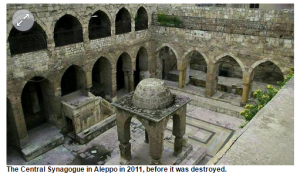
The Great Synagogue of Aleppo is between fifteen hundred and three thousand years old and was in use until 1992 when almost all of the Jews departed. After the conquest of Aleppo around 950BC, King David gave to Yoab ben Seruya, general of King David’s army the city of Aram Soba (Aleppo). After receiving the city, Yoab who always dreamed of building a house of worship took on the project of building the Great Synagogue (The Sephardic Heritage Museum 2016: 36, 37).
Rabbi Refael Shelomo Laniado, who served as chief rabbi of Aleppo during the 18th century and Rabbi Abraham Dayan, a leading Aleppan scholar during the 19th century both stated that the synagogue was built during the second Temple period over two thousand years ago. The most conservative estimates offered by scholars place the synagogue’s construction between the fourth and fifth century CE. They cite the synagogue’s Byzantine architectural style to support this claim ( ibid. 39).
Until the nineteenth century synagogues could not be built in Aleppo. Jews had to justify the existence of the Great Synagogue by stressing its antiquity in attributing the synagogue to Joab son of Seruya. Ceremonies such as blowing of the shofar on the Jewish New Year and celebrating Purim had to be conducted in a way as not to disturb Muslim neighbors (Zenner 2000: 39).
Page created by Carol Silvera


